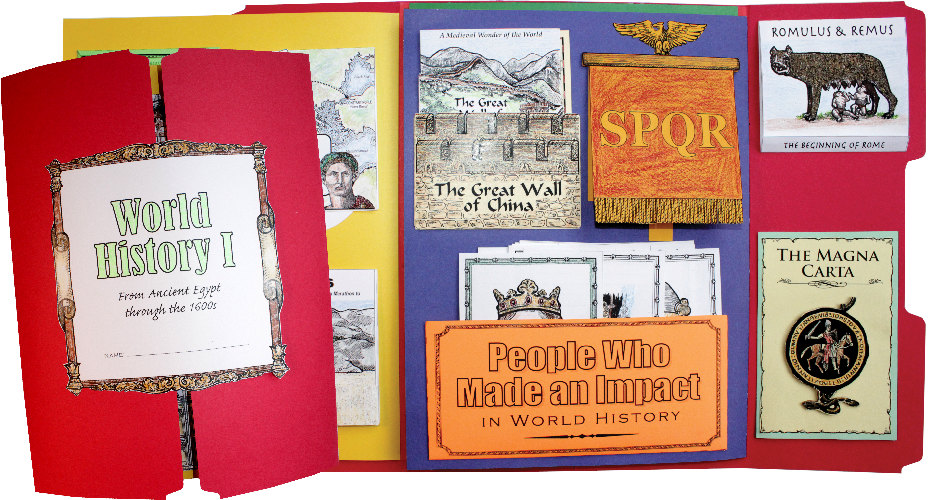InquisiKids has created two lap-book kits for world history: World History Lap Book I and World History Lap Book II. The first kit covers historical events from ancient history up through the 17th century. The second kit covers events from the 17th through the 20th centuries.
These kits are best for students in grades six through eight. (The publisher suggests age ranges for these two kits of 11 to 13 and 12 to 14, respectively.) Both kits can be used with almost any world history course. On the Inquisikid’s website, you can see the lengthy list of projects that go into each lap book, so you can determine in advance how they might fit with whatever curriculum you are using. Click here for the list of projects in World History Lap Book I and click here for the list for World History Lap Book II.
Each kit comes in a sturdy cardboard box and includes almost everything you need except colored pencils, a stapler, clear tape, a needle or a push pin, a craft knife, and scissors. (For the first kit, you also need some finely-ground black pepper.) Kits include an instruction book, pre-cut file folder sections on which you will build the lap book, a large stack of pre-printed pages (including many on colored card stock), and a baggie with a few supplies such as double-sided tape, all-purpose glue, glue sticks, glitter, and a brad.
The full-color instruction books provide illustrated, step-by-step directions for the individual projects that go into each lap book. There are 30 projects for the first lap book and 28 for the second. Each of the individual projects should take from one to two hours to complete.
Many of these activities involve constructing lap book components with clever cut-and-fold techniques, so students need to follow the instructions carefully. Some helpful tips at the front of each instruction book are critical, so be sure to read those before beginning.
These lap books do not try to cover every important person and event. They are necessarily selective so that they can be completed within a reasonable amount of time. For instance, the first kit includes projects on the unification of Egypt, the Trojan horse, Augustus and the Pax Romana, the Rise of Islam, social class structures in medieval Europe, The Magna Carta, Gutenberg’s printing press, and Leonardo da Vinci. Among the projects in the second kit are those on the three great unifiers of Japan, the slave trade, the universal laws of Newton and Locke, the U.S. Constitution, the French Revolution, South America after independence from Europe, the U.S. Gold Rush, Canada, the Russian Empire, Hitler’s climb to power, and five world conflicts of the 20th century.
To keep things manageable, the kits have a lot of text on some of the printed pages, so students need not invest a great deal of time writing. Some projects provide students with the options of either using pre-printed material or writing in their own information. A few projects require students to research and answer questions. There are a few pages at the end of each instruction book that have suggested answers for the sections where students need to research and answer questions.
I believe that students in sixth through eighth grade should be spending more time reading and writing as they learn than in earlier years, and they should need less hands-on activity. At the same time, I am a fan of lap books as a way to address the needs of the many students who still benefit from hands-on activity to stimulate their interest and attention in ways that regular course work cannot. And these lap books do that very well.
Amy Pak of Home School in the Woods, a talented designer and illustrator, created the pages for these kits. Her excellent illustrations and creative designs should help students produce impressive, high-quality lap books.








